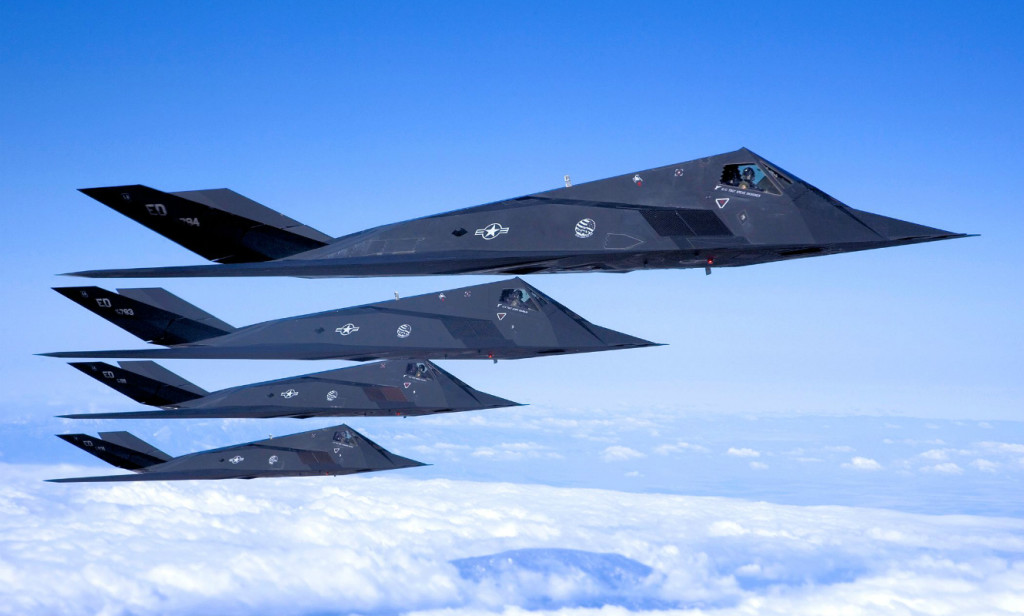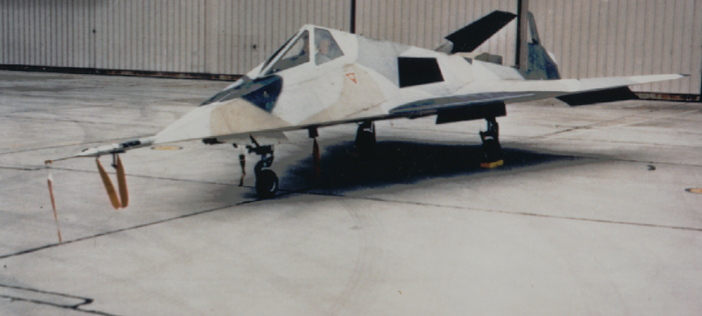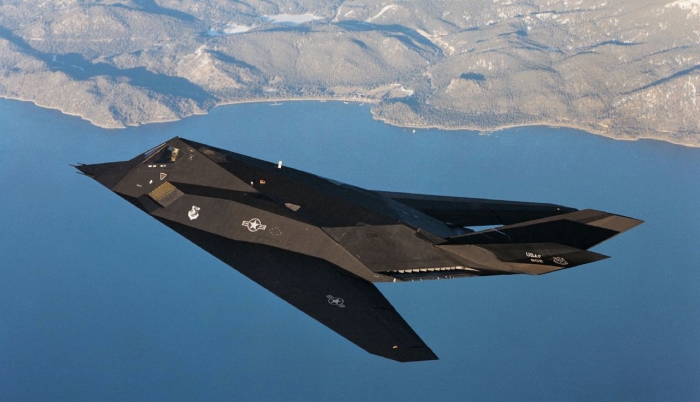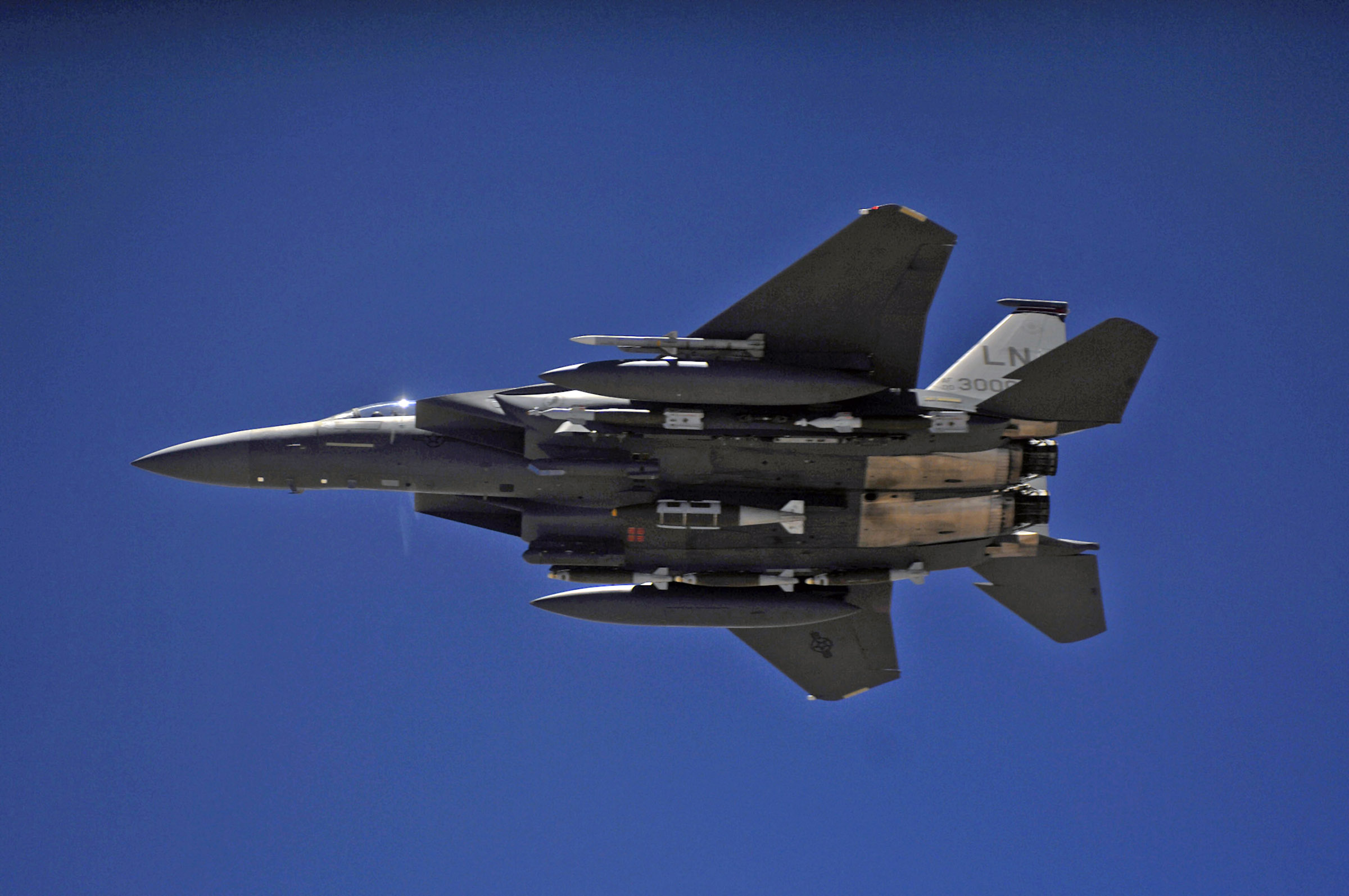The U.S. Air Force and Stealth: Stuck on Denial Part I

Note: This article is the first of a series addressing the challenges facing the Air Force’s combat aviation capabilities in the future. The series, titled “Stuck on Denial,” addresses the root of the Air Force’s combat aircraft procurement problem — that the service remains stuck in the denial phase of the grieving process over the vision of an exquisite, all-stealth force. It examines the path that led to the Air Force’s overcommitment to stealth, unravels the assumptions that led to that commitment, and offers alternatives that are more broadly applicable to tomorrow’s airpower challenges while remaining affordable and technologically feasible.
In the early morning of January 17, 1991, 10 F-117 Nighthawks slipped through the air over Iraq. The aircraft, designed for a Soviet threat in Europe, were perfectly suited for penetrating Iraqi airspace, which relied almost entirely on Soviet air defense systems. The F-117 was designed to be as stealthy as possible: Its faceted shape reflected radar waves away, the exhaust was baffled and mixed with cool air, and the aircraft was painted a non-reflective black. No betraying emission slipped free, as the aircraft had no radar, no radar altimeter, and no datalink, and the pilots retracted the radio antennas and turned the radios off. It was too quiet to easily hear from the ground. Undetected by alert air defenses, the F-117s were able to deliver laser-guided bombs that arrived with no warning. By the time Operation Desert Storm ended, the Air Force had a new favorite technology. Stealth was in, and it was forever the answer to the challenges of penetrating defended airspace. An undetectable aircraft was an airpower theorist’s dream.
Twenty-five years later, the Air Force remains latched on a concept it is loath to let go of, regardless of the cost. But the air defense environment has changed since 1991, and not in ways that favor American airpower. While the Air Force is constantly attempting to technologically outmaneuver our adversaries, it is unwilling to accept that we can also be technologically outmaneuvered — and that we have been. The Air Force should be dealing with the reality that no military advantage lasts forever, and instead we are stuck on denial.
The Air Force’s unwavering commitment to an all-stealth force is based on a mindset from Desert Storm — America’s last unambiguous military victory. Even then, the majority of targets were struck by non-stealthy aircraft spread throughout a multirole force. The coalition could not have delivered the same results had we possessed an all-F-117 force; a diversified force is a requirement for the kind of air campaign we executed. Stealth aircraft have their place. All other things being equal, signature reduction always works to some extent. Nevertheless, the design tradeoffs and expense associated with stealth aircraft make them less flexible and arguably less useful than their true multirole ancestors. In an uncertain defense environment, the Joint Force is deeply in need of a flexible force and not a niche force designed for the least likely of conflicts.
Understanding Stealth
In order to understand the Air Force’s commitment to low observability (LO, or more popularly, stealth) we have to consider the history. Radar low observability is not particularly complicated or arcane, but the its application on specific weapons systems is a closely held secret, rarely discussed openly and as a result poorly understood. In this article, I draw exclusively from sources in the public domain for explanations of the basic scientific principles behind stealth.
Radar works by beaming radiofrequency (RF) energy at an object. The result of this is that the energy is scattered. Energy that scatters back towards the observer (called “backscatter”) creates a radar return, or echo. As radar was emerging during World War II, radar designers realized that some aircraft were less detectable than others. The Royal Air Force’s Mosquito fighter-bomber, made of fabric-covered plywood, was notoriously difficult to detect on radar, despite its radar reflective engines. In the 1950s, Western and Soviet designers developed methods to measure an aircraft’s radar signature by building scale models and making measurements in the laboratory.
William F. Bahret (quoted extensively here) at Wright Field’s Avionics Lab was a pioneer in “radar camouflage” and is sometimes called “the father of stealth”. Bahret’s team developed techniques to measure the impact of both shape and materials on radar signature (then called “echo size”). More importantly, he developed the capability to calculate radar signature without having to build a scale model.
Bahret needed to determine which design features mattered. Metal reflected. Curved features mattered a lot — they were guaranteed to scatter some radar energy back at the receiver. Inlets, cockpits and exhausts were very effective reflectors. Spinning jet turbines were like holding up a disco ball in a spotlight. Antennas were worse because they were intended to propagate RF energy in the first place and do that job well regardless of where the energy comes from. By the 1960s, Bahret’s design theories were being applied — the Hound Dog missiles were among the first recipients of a signature reduction effort. His work placed the United States decades in front of Soviet scientists researching the same thing. Ironically, Soviet physicist Peter Ufimtsev was allowed to publish a foundational book on low observability in 1962 because it had no military value — a translation came into the hands of U.S. Air Force scientists in 1971 and helped justify early stealthy aircraft demonstrations.
U.S. aircraft designers could “build” an aircraft on paper and evaluate its signatures with a computer. One major challenge was the intersection of radar science with aeronautical engineering — it was much easier to build a stealthy shape than it was to build one that could fly. The majority of radar camouflage has to do with the shape of the object — shaping counts for 90 percent of the signature reduction. This meant that properly shaped metal could still be used for construction. Flat surfaces reflected energy in predictable directions away from the radar receiver, but you couldn’t build an aircraft out of flat surfaces. An aircraft faceted like a gemstone couldn’t fly, because the pilot could not control it. Soviet designers concluded that a stealthy aircraft could not be built. The design challenge was summarized by William Bahret in a 2006 interview:
[T]he most powerful technique of all is shaping. And that’s where flight dynamics people and the propulsion people and everybody else get in the act because if you shape the thing properly, oh man, are you way ahead of the game. Again, F-117 is the case in point. And that twists the aerodynamics guys, the structures guys and other people out of their normal routine because it’s back to the drawing boards now. We’ve got to start over with some new stupid looking shape and make that fly. And that’s sometimes more difficult [than] it appears.
At Lockheed’s Skunk Works in Palmdale, Ben Rich argued that a faceted, stealthy aircraft could fly, even an aircraft with stealth as its primary requirement. Sure, it wouldn’t carry much, would not be high performance, and would be aerodynamically unstable, but with NASA’s new computer-controlled fly-by-wire systems, it could be controlled. Lockheed built two demonstrators codenamed HAVE BLUE, using a quadruply-redundant fly-by-wire system from the YF-16. First flown at Groom Lake in 1978, the aircraft performed as expected — short on lift, unstable in pitch, prone to excessive sink rates — and very, very difficult to see on fire control radar. Both were lost in crashes, but they led directly to SENIOR TREND, which would first fly in 1981 as the F-117A.

Reducing the radar signature of a fighter-sized target was a major achievement. Perversely, it is easier to reduce the RF signature of a large object than a small one, because of the way radio waves scatter. Even a perfectly radar-absorbent sphere scatters energy if the radar wavelength is greater than the sphere diameter, a phenomenon known as Rayleigh scattering. Fire control radars, which operate in higher frequencies, are more greatly affected by signature reduction than radars in the VHF band (30 to 300 MHz). At the time, The Soviets used VHF extensively, but it was imprecise and used only for early warning.
As William Bahret explains:
What this means in simple terms is that at what are called “microwave frequencies” — those above 2000 megahertz (mhz) — a normal aircrafts’ echo derives from a set of individual sources, while at much lower frequencies, the increasing tendency is for the entire aircraft to act like one big source — with only the general shape being a factor. At extremely low frequencies, even the shape loses influence and only the volume matters.
The Stealth “Fighter”
The F-117A looked like HAVE BLUE — a flat bottom, canted tails, faceted shape and high-mounted engine intakes covered with gratings. Operational in 1983, it was not publicly revealed until April 1990, a scant few months before Iraq’s invasion of Kuwait. Until 1988, the Air Force publicly denied its existence. It was not a fighter, but a light bomber without a scintilla of air-to-air capability, capable of carrying two 2000-lb. weapons. The aircraft was designed to fly at medium altitude under the control of a digital autopilot, pass directly over a target, and drop laser-guided bombs on an unsuspecting adversary. Its radar cross section approximated a marble. To Soviet early warning radars of the time, such as BAR LOCK, BACK NET and LONG TRACK, the aircraft might as well have been invisible. Only the VHF-band SPOON REST and TALL KING radars would have had a chance at detection and only in the hands of a skilled and alert operator.
Designed for penetrating a Soviet air defenses, the F-117’s stealthy characteristics depended as much on what it didn’t do as what it did. It flew only at night, attacking fixed targets acquired on infrared. The laser used to guide weapons is invisible. It lacked afterburners, a bubble canopy, external stores, a radar altimeter, datalink or self-protection jammers. With only retractable radio antennas, it was virtually aperture free. As William Bahret recounted in 2006:
[T]he things that cause big echoes are not surfaces, but they are what we call apertures. Apertures are anything — garbage pail, antenna, an inlet — that captures energy, and it runs in and around and everything and comes back out somehow.
On the first night of Desert Storm, F-117s flew into Baghdad ahead of jamming from the EF-111 or anti-radiation missiles from the F-4G. The Iraqi Kari system was a French command-and-control system that linked Soviet-designed interceptors, surface-to-air missiles (SAMs) and radar-directed antiaircraft artillery (AAA). The backbone of Iraq’s early warning network was Soviet-supplied P-35/37 BAR LOCK radars, which could expect to detect a 1 meter squared target at about 100 nautical miles. Detecting a flying marble was something else entirely. Further stacking the deck in favor of the F-117’s was the massive coalition air force, which contained standoff jammers and defense suppression aircraft, giving radar operators plenty to look at while F-117s approached unobserved. No F-117s were so much as scratched by Iraqi defenses.

After the opening minutes, F-117s didn’t actually go anywhere that conventional aircraft didn’t go, and didn’t hit any targets that other aircraft did not also hit. They also flew only interdiction sorties against fixed targets, making very good use of their specialized capabilities. Strategically, the effectiveness of the F-117 came as a very unpleasant surprise to the Iraqi defenders and to their suppliers. But once the Russians realized what had been done, they realized how. After all, their scientists knew the theory as well as anyone, they just didn’t believe that theory could be put into practice. The United States proved them wrong. This instigated a massive and sustained revolution in foreign radar design to diminish the threat. The success of the F-117 sparked major investments to ensure that its success could not be repeated against Russia or China.
No military advantage lasts forever, and now the cat was out of the bag. The secrecy surrounding the F-117 paid big dividends, but even minor powers were paying close attention and studying methods to counter it. In 1999, Col. Zoltan Dani of Serbia’s 3/250th missile brigade bagged an F-117. No accident this; Col. Dani’s battery also shot down an F-16C, making him the only successful air defense commander of the entire conflict. The radar he used to track the F-117 was the P-18 SPOON REST D, a 1970 upgrade of a 1956-vintage VHF early warning radar that was the lowest-frequency mobile radar produced by the Soviet Union. The F-117 was shot down by an SA-3 LOW BLOW, first fielded in 1961. A mere eight years after Desert Storm, air defenses had shot down an F-117 using equipment in Iraq’s inventory almost a decade before.

The Stealth Penalty
The penalty paid by the F-117 for its stealth was substantial in terms of payload, sensors, and performance. This effect of designing for RF stealth is common to fighter designs. Internal weapons bays limit munition sizes and numbers, and the lack of external fuel tanks limit range. The F-22 is heavier than the F-15E, but the F-15E’s typical fuel load is 70 percent greater than the newer aircraft and its loadout (bombs and fuel) dwarf’s the F-22’s by a factor of six or more. The expense of maintaining the stealth fighters is also higher than any of the legacy jets; USAF data from 2012 showed the F-22’s flying hour cost almost double the F-15E.

There is a further penalty associated with the maturing of the aircraft. With a traditional jet, additional capabilities can be added or modified with little regard to signature. The F-4 was a prime example of this, with ten major front-line variants (and three subvariants) in U.S. service alone, most of them serving at the same time. The F-15 and F-16 are not far behind, especially when international versions are considered. But the F-22A remains externally the same more than a decade after it reached initial operating capability (IOC). In order to stay stealthy, the aircraft’s outer mold line must remain unaltered, limiting the nature of possible upgrades.
For any weapons system, a long public timeline ensures that the adversary is researching counter-technologies while the weapon is being developed. When the F-117A was first publicly displayed it had already been used in combat the year before in Panama and the public still didn’t know what it looked like. It was flown at night from a secret base in the middle of nowhere. The adversary didn’t know what it looked like until the public did. The lack of knowledge about the F-117 not only obscured its shape, but its role and the effort that had been put into low observability. Adversary scientists could not develop counters for an aircraft that possessed an unknown set of attributes.
Contrast this with later stealth fighters, which had no such security. High-resolution photos taken from multiple angles were available to adversaries for years. As a result, Russian and Chinese designers have had some time to consider counters to aircraft they have been allowed to see coming for many years. The YF-22 was rolled out in 1989, more than a quarter century ago, 16 years before the F-22A became operational and before the F-117 was revealed.
After the Gulf War, foreign designers had two revealed shapes to analyze, and detection was made easier by the supersonic stealth fighters, which have radars, datalink, and afterburning engines. New designs departed from the F-117s philosophy of minimizing signatures across the board. One fact sheet advertises “supercruise,” as if aerodynamic heating didn’t exist and supersonic shockwaves were undetectable. Another highlights an engine capable of delivering 43,000 pounds of thrust, failing to note that it is also the hottest jet engine ever mounted in a U.S. fighter. In 1990, the only operational VHF early warning radars were the Soviet-designed TALL KING and SPOON REST (and Chinese copies), but newer systems have both advanced and proliferated outside China and Russia. The air defense environment has advanced very far very quickly, and the comparative overmatch of the F-117 in 1991 is long past.
Implications
The primary reason for not putting all of the airpower eggs in the stealth basket is flexibility of airpower in general, particularly the flexibility lost with a stealth design. It isn’t that stealth aircraft are expensive, although they are. It isn’t that the expense to fly them is so high that it limits the flying hours for the aircrews, although this is also true. It’s that the attributes we often need in a combat aircraft are range and payload, which are not deliverable with our stealthy fighter designs. It’s that aircraft designed for certain roles, such as close air support, have fundamentally different design requirements from a stealthy penetrator.
There is value in having stealthy aircraft — 49 F-117s and 20 B-2s have done stellar work in several conflicts. However, there is less value in having an all-stealthy force, precisely because the aircraft are so limited for the majority of applications that the United States uses its airpower for. We have not had to penetrate air defenses en masse since Allied Force in 1999; the majority of airpower application since then has prioritized endurance, weapons loadout and adaptability. Had we fielded the stealth fighters earlier and had them available in 2001, the Air Force would have ruined the entire fighter / attack enterprise trying to execute the year upon year missions required in Iraq, Afghanistan, Libya, or Africa — and been unable to deliver the same airpower effects as the legacy force. In the Pacific, range and payload are the key airpower attributes and the reason why we relied so heavily on the B-29 in World War II — or the B-52 in Vietnam. In Europe, the ability to operate under the weather has always been highly prized. Over friendly troops in contact, endurance and firepower are highly prized — and the reason why soldiers and Marines exhibit a preference for the A-10C and AC-130. It is notable that none of the characteristics for which the stealthy aircraft have been optimized has been useful in combat for the past seventeen years. In the meantime, we have been technologically outmaneuvered by both Chinese and Russian air defense designers, as we double down on a technology that gave us a decisive advantage a quarter century ago. We are building the combat air force for the wrong attributes, and we are unlikely to reconsider this path as long as the Air Force remains stuck in denial.
Col. Mike “Starbaby” Pietrucha was an instructor electronic warfare officer in the F-4G Wild Weasel and the F-15E Strike Eagle, amassing 156 combat missions and taking part in 2.5 SAM kills over 10 combat deployments. As an irregular warfare operations officer, Colonel Pietrucha has two additional combat deployments in the company of US Army infantry, combat engineer, and military police units in Iraq and Afghanistan. The views expressed are those of the author and do not necessarily reflect the official policy or position of the Department of the Air Force or the U.S. government.
Photo credit: Bobbi Zapka, U.S. Air Force

